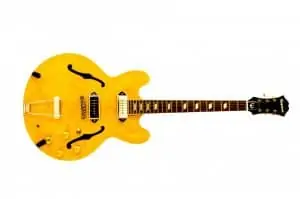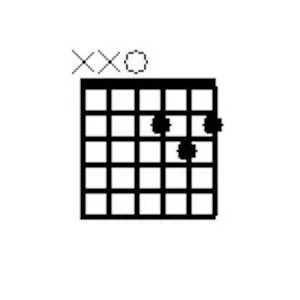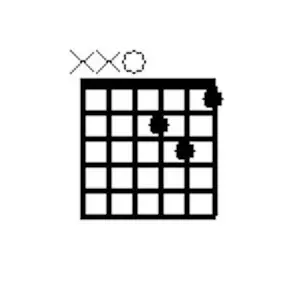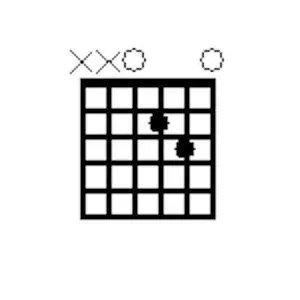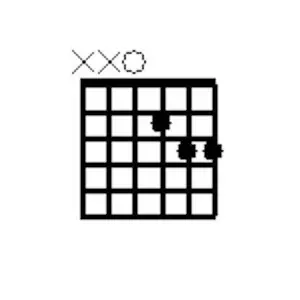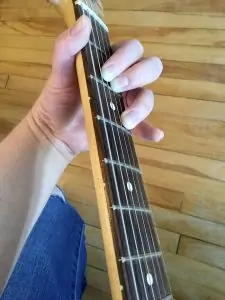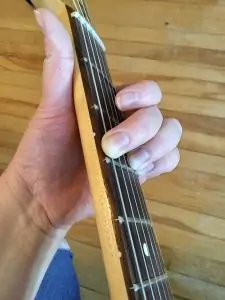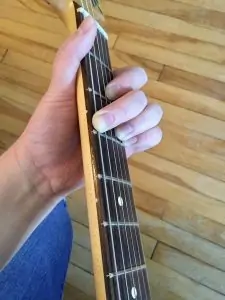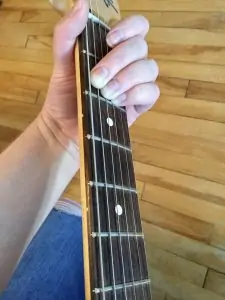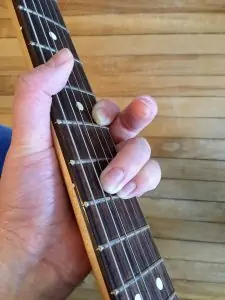As Axis of Awesome’s “Four-Chord Song” proves, you can play (almost) any popular guitar song with only a handful of major and minor chords.
But what if you want to break out of the G-C-D-Em rut? Shake up a tired chord progression? Learn something new?
This is when sus chords come in handy.
Sus chords have been around since the Renaissance. But it wasn’t until the 1950s that jazz guitarists gave them new life.
These special chords have been popular across genres and decades –– from modal jazz to folk rock to new wave to funk. Who knows? They might even become one of your go-to songwriting chords.
But before you switch out all your majors and minors, let’s talk about when to use these chords for maximum impact…
Contents
First Things First
At this point, you might be wondering what sus chords are.
The good news is that there’s only one note difference between them and your major or minor voicings. It may be a small change. But it has a big effect on the feel of a progression.
What are they?
Major and minor chords consist of three notes:
- The root (1st scale degree, or tonic)
- The 3rd scale degree
- The 5th scale degree
For example, a D chord is built from the D major scale – D E F♯ G A B C♯ D. It contains the notes D (root), F♯ (3rd) and A (5th).
Meanwhile, a D minor chord is built on the D natural minor scale – D E F G A B♭ C D. It has the same root and 5th as the D major, but a flat 3rd (F) instead of a natural 3rd (F♯). This is why a minor chord is usually fretted the same way as a major chord, but with the 3rd note lowered by one half tone.
When you play open D (left) and Dm (right), the 5th scale degree is on the 3rd (G) string. The root is on the open 4th (D) string and fretted 2nd (B) string. Finally, the 3rd scale degree is on the 1st (high E) string
Sus chords have the same root and 5th. But they replace the 3rd with either the 2nd or the 4th scale degree. For example, D2 is just a Dm with the flat 3rd lowered another half tone to the 2nd (E). Meanwhile, D4 is a D chord with the natural 3rd raised one half tone to the 4th (G).
The open voicings for D2 (left) and D4 (right)
When they want a fuller sound, jazz guitarists re-add the 3rd scale degree, but at a higher octave. This way, the sus note still rings loud and clear.
If you find a sus with no number, this refers to the sus4, which is more common than the 2. This is because the perfect 4th (the distance between the root and 4th scale degree) is the most consonant (pleasant sounding) interval after the unison, octave and perfect 5th. It’s not that the major 2nd interval doesn’t sound good. It just doesn’t sound as “perfect” as the 4th.
On a final note, when you compare guitar tabs, you might notice that a chord appears in one as a 2 voicing and the other as a 4 of an entirely different note. This is because every sus2 is an inversion of a different sus4 and vice versa.
Let’s go back to D4. When you mute the 4th string, the chord is in 1st inversion The bass note is the 5th scale degree (A), followed by the root (D) and 4th (G). This group of notes could also be the 2nd inversion of G2, belonging to the G major scale – G A B C D E F♯ G. The 2nd scale degree (A) forms the bass note, followed by the 5th (D) and the root (G).
Why are they called “sus chords”?
Sus is short for “suspended.” It was originally a term borrowed from counterpoint –– when you compare the rhythms and pitches between two melody lines. One way to create dissonance (musical tension) between these lines is to add suspension. This happens when you carry over a note from one chord into the next chord, before resolving to a consonant interval like a unison or perfect 5th.
For modern guitarists, “sus” takes on a new meaning as a single chord that creates suspense. When you add the 2nd or 4th scale degree, it creates a neutral, uncertain sound that’s neither major or minor. It’s pleasantly dissonant, but not as startling as a diminished or augmented chord. So, you can use it in different progressions without unleashing a cacophony of notes.
Because these chords sound unfinished, they also create movement. They leave listeners wondering how (and when) those 2nd and 4ths notes will be resolved…
Basic Shapes
The easiest way to fret sus chords is to think about where your 3rds are in your majors and minor triads. Then, you can raise or lower one finger to fret the right note.
When a chord voicing has another root note at a higher octave, you can also raise it by one whole tone to fret your 2nd scale degree.
Open position
We looked at D chord charts in the last section, so let’s move on to A. Start with an open 5th (A) string and your fingers on the 2nd fret of the 4th, 3rd and 2nd strings.
To turn your A into A2, lower the 3rd one whole tone by lifting your ring finger and playing the open 2nd string. To turn it into A4, raise it one half tone to the 3rd fret of the 2nd string.
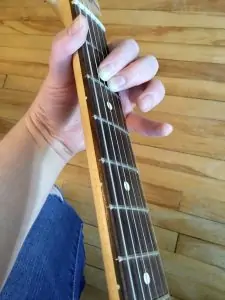
Open chord voicings for the A2 and A4.
This same method works when adding the 2nd or 4th to your C and G chords. But for C, you need to mute your E strings (6th and 1st). For G, add your ring finger to the 3rd fret of your 2nd string.
Another C2 option is to play your Cadd9 shape, but with an open 4th string. You can also play G2 in standard position with a muted 5th string and your index on the 2nd fret of the 3rd string.
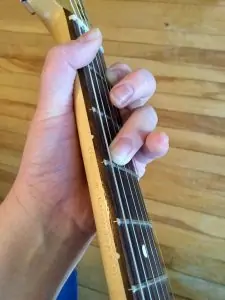

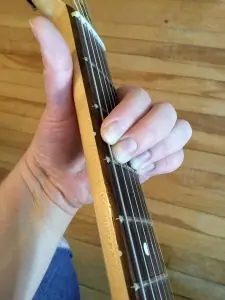
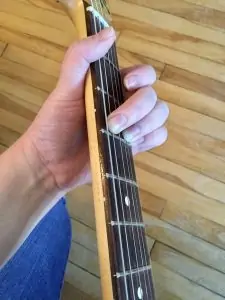
The standard voicings for C2 (top left), C4 (top center), G2 (top right) and G4 (bottom left). You can also use alternate voicings for C2 (bottom center) and G2 (bottom right).
Things get trickier when your move to E. For E4, you can raise your finger from the 1st fret to the 2nd fret of your 3rd string. But Em already uses an open 3rd string. So how do you play the 2nd scale degree?
You have two options:
- Raise your finger from the 2nd fret to the 4th fret of the 4th string. If you’re familiar with the notes on your fretboard, you’ll know that this turns the E octave into an F♯, the second scale degree.
- Add your little finger to the 2nd fret of the 1st string. This is my favorite E2, because you don’t need to stretch as far to play the F♯.
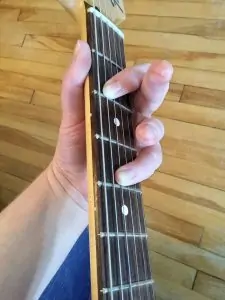

The two open voicings for E2 (left and center) and the open voicing for E4 (right). For the first E2, you’ll need to mute the top three strings.
These open shapes are great for keys like G major and A minor that primarily use these five chord roots. For other keys, you’ll need to learn some moveable shapes.
Moveable shapes
Just like your major and minor barre chords, sus chords can also be adapted to moveable shapes when you need to slide up and down the fretboard.
For E-string root chords, I actually find it easier to mute the 6th and 5th strings. This way, you can use the same shapes as your F major.
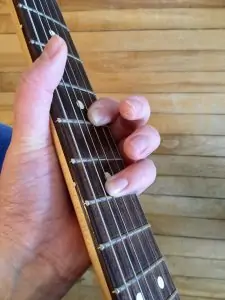
The F2 shape (left), with a mini barre across the 1st-3rd frets, and F4 shape (right), with a mini barre across the 1st-2nd frets, are excellent substitutes for a full E-shaped barre –– especially when you’re a small-handed player like me.
For fuller sounding chords, you can always take your E4 and first E2 shape. The E2 is too big a stretch for me, so I almost never use it. But you might find that it works for you.
The A-string root and D-string moveable shapes should be easy, no matter what size your hands are. Just don’t forget the mini barre with your ring finger for your 4s!
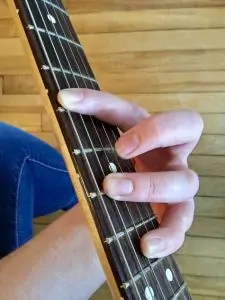
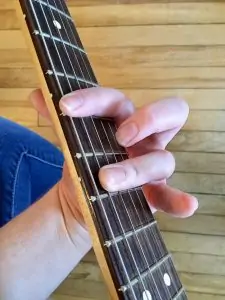

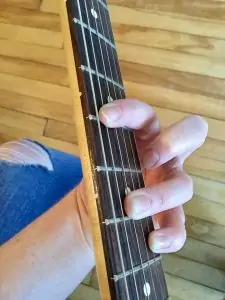
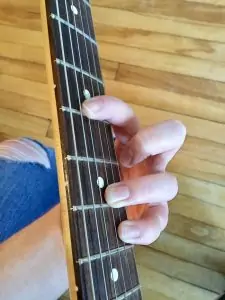
Moveable shapes based on the E2 (top left), E4 (top center), A2 (top right), A4 (bottom left), D2 (bottom center) and D4 (bottom right).
Variations
The beauty of sus chords is that you can combine them with various extended chords when you want to add more color and depth.
The most popular extensions are:
- Maj7s
-
- 7s (also called dom7s)
- 9s (for 4s only –– the 2nd and 9th are the same note at different octaves)
- 13s
Maj7s, 9s and 13s are favorites in funk, jazz and soul. Aside from jazz, 7s are also used in blues, rock and folk.
I find that the easiest way to fret these chords is to find the roots and 3rds in a regular extended voicing and make adjustments from there. However, you can memorize more moveable shapes.
When To Use Them
Most of the time, you can use a sus chord instead of (or in between) any major or minor. This can be a fun way to…
- Freshen up a humdrum progression
- Add a dreamy or ambiguous feel
- Change tension within a chord
- Smooth transitions between chords
V chord substitutions
The most radical use of 2s and 4s is to use them in place of existing majors or minors. You can do this with any chord in a progression. But the most common choice is the 5 chord (V).
Let’s say we’re in the key of D major.
The D major scale contains the notes D E F♯ G A B C♯ D.
In relation to the D tonic scale, A (the V chord) contains the 5th (A), 7th (C♯) and 2nd (E) scale degrees. As the dominant (5th) tone in the scale, A has a consonant relationship to the D tonic, thanks to that perfect 5th interval. Meanwhile, as the notes on either side of the tonic, the C# leading tone (7th) and E supertonic (2nd) have a strong pull to resolve to D major.
This is why chord progressions like D A D sound so satisfying. You get just enough tension from the V, followed by release from the I.
A2 substitutes the C♯ leading tone with the B submediant (6th scale degree). Meanwhile, A4 substitutes it with the D tonic. Without the 7th, these voicings have less pressure to resolve to the D chord. But when they’re used as standalone chords, the dissonant relationship between individual notes adds an ambiguous touch. They thwart listeners’ expectations about where the progression will go, leaving them curious to hear what will happen next.
This “detour” can also work wonders whenever the V chord isn’t followed by the I chord. For example, in the intro to “Purple Rain” by Prince (key of B♭), the chords are I vi V IV. The IV chord is a E♭9, with the notes E♭ G B♭ F. F2 (F G C) shares two notes in common, while F major (F A C) only shares one. So, the F2 creates a smoother chord transition.
After the intro of Purple Rain, the V becomes a regular major, while the I and IV are replaced with 2 voicings.
Dominant chords (V7s) are even more tense than regular Vs. This is because they contain a tritone –– an interval of two notes that are 3 whole tones away from each other. You’ll find this between the 3rd and♭7th notes of the chord, such as the C♯ and G in A7 (A C♯ E G).
Tritones are the most unstable interval. So, whenever you add one to the V chord, you create an even greater pull toward the I.
When you raise or lower the 3rd scale degree, V7s lose the tritone. Because of this, V7sus chords are often used to mellow out a progression –– without losing momentum or creating too much dissonance.
What if you want to add the cool sound of the 4th scale degree without losing your tritone? In this case, it’s better to use a Vmaj7sus4, which has a tritone between the 4th and natural 7th (D and G♯ for an A). Because of their extreme tension, these types of chords work best when leading to the tonic.
Sometimes, you can substitute other chords in a progression for V2s or V4s. For example, In a ii-V-I major progression like Em7 A7 D, you can replace the ii7 with a V7sus4. This creates a smoother transition, because the ii and V voicings share three common notes. A7sus4 contains A D E G, while Em7 contains E G B D.
However, things get trickier when you have a ii˚-V-i minor progression like Edim7 A7 Dm. Unlike the natural 5th note in the Em7 (E G B D), the Edim7 contains a flat 5th (B♭). To keep this note, you need to fret an V7(♭9)4. You can do this by sliding the A octave in your regular A7sus4 up one half tone.
Aside from V7s, V9s are the most common extensions to use 4s. V9sus4s are so common in jazz progressions that they’re sometimes called jazz sus chords. They’re often used to replace a V11 voicing, since they’re almost the same chord. However, V11s still keep the 3rd scale degree –– just at a lower octave.
V9sus4s can appear in other genres too, when you want a dash of jazzy dissonance. For example, in the D minor section of Pink Floyd’s “Dogs,” the progression is Dm9 E♭maj7sus2/B♭ A9sus4 A♭2(♯11). Like the other 2s and 4s, the A9sus4 heightens the soaring, surreal feel of the song.
Other chord substitutions
Outside the V chord, the sus2s are the more common chord substitutes in major keys. Because of their gentler sound, they’re less likely to derail the harmony than 4s.
2s are sometimes used as I chords. You can hear this in the song “Cautioners” by Jimmy Eat World. It has an A2 tonic and regular voicings for the IV (D) V (E) and vi (F♯m). Because the 2nd scale degree (B) also appears in the V chord (E G♯ B), this creates a strong finish when the V resolves to I (A-B-E) at the end of the chorus.
The Isus2 also sounds at home in Mixolydian mode, especially as a dom7. As a consonant major 3rd interval, the ♭7th and 2nd scale degrees work together to create a deep, mysterious tone that works especially well in major blues.
In major keys, the relative minor (vi chord) can become a 2. By adding the leading tone of the tonic scale, you create a stronger push to resolve to the I.
2 voicings also sound good as IV chords. For example, the pre-chorus riff to Stone Temple Pilots’ “Plush” (key of G) has a D5 C2 and G/B progression. Because the C2 (C D G) has a D note, it helps connect the D5 (D A) and G/B (B D G).
The C2 in Plush also contributes to the dissonant, grungy feel of the song.
However, when you want to make a IV2 a 7 chord, it’s better to use a IVmaj7sus2. Otherwise, you would end up playing the ♭3rd instead of the natural 3rd of the tonic scale.
In minor keys, the most common place to substitute a 2 or 4 is the subtonic (VII chord). Let’s say we’re in the key of Am – A B C D E F G A. The Am chord consists of A C E, while G2 contains G A D and G4 contains G C D. Because they each share a note with the tonic, both voicings can fit easily into a progression. Their dissonance can also make the harmony sound more sad and soulful.
In an A major scale, A B C♯ D E F♯ G♯ A, the G chord would be a ♭VII. Although the G4 wouldn’t work in this context (it has a C instead of a C♯), the G2 amps up the dissonance, intensifying the pull toward the I chord.
In case you were wondering, you can build an entire progression of sus chords –– especially in jazz. The most famous example of this is Herbie Hancock’s “Maiden Voyage” (D7sus4 F7sus4 E♭7sus4 and C♯7sus4). The repetition of these dream-like 7 voicings give you the illusion of floating alongside the saxophone and piano melodies.
Passing chords
So far, we’ve only looked at sus substitutions. But because they carry more tension than your average major or minor, they don’t always work as standalone chords. Instead, most guitarists use them as passing or leading chords. This happens when you insert them into existing progressions to connect different chords together.
Let’s look at another classic song –– “Pinball Wizard” by The Who (key of B major). Verse 1 consists of B4 B A4 A G4 G F♯4 F♯. By prefacing each chord with its sus4, the progression becomes more dynamic and suspenseful.
In the final verse of Pinball Wizard, the song modulates to a new key (D major). But it still maintains alternate sus4 and major voicings.
Sometimes you’ll only find one sus passing chord. When you do, this is usually a I2 or I4, used to bring the listener “home” to your regular I chord. You can hear this in the G4 G cadence (ending sequence) of the verses and chorus in Gnarls Barkley’s “Crazy.”
Sus chords can also smooth out a progression in classical-style suspension –– namely, when you sustain one note from the previous chord and link another note to the following chord. Let’s go back to “Crazy.” The full cadence is A♭G4 G. A♭and G have no notes in common (A♭C E vs. G B D). However, the G4 substitutes the B with a C. Because it shares notes with both chords, G4 becomes the perfect passing chord.
Pedals
When guitarists talk about pedals, they’re referring to different chords that are played over a sustained bass note (usually the root). Sus chords work great in pedals, because they share the same root and 5th with majors and minors.
One of the most famous examples is the intro to Queen’s “Crazy Little Thing Called Love” – D D4 D. The alternating 3rd-4th note rhythm is way more interesting than a continual 3rd. Plus, it creates movement, pulling you immediately into the rhythm of the song.
Another cool way to use pedals is to arpeggiate a chord instead of strumming all the notes at once. This helps when you want to draw extra attention to the 2s and 4s. For example, Radiohead’s “Street Spirit (Fade Out)” uses an arpeggiated Am A2 A4 sequence throughout the song.
The unresolved 2nd and 4th notes in “Street Spirit” complement the overall feeling of hopelessness and melancholy.
Prosody
Maybe there’s nowhere in a progression itself where it makes sense to add a substitute or passing sus chord. But what if you want to use it to highlight a particular lyric? This is where prosody comes in.
Prosody is just a fancy word for the relationship between lyrics and music. It can describe how rhythm and words complement each other –– or how the chords/notes and words work together to create emotions.
You can use 2s and 4s whenever you’re dealing with lyrics that are uncertain, dreamy, wishful, mysterious, mellow (in major key songs) or melancholy (in minor key songs).
One example of this is “Hey Jude” by The Beatles. In “take a sad song and make it better,” there is a C7sus4 chord change on the word “song.” This neutral but strangely uplifting chord fits perfectly between the polar opposites of “sad” and “better.”
The chords for piano and guitar are the same in the first verse of “Hey Jude.”
Aside from specific lyrics, sus chords can be used when you want to highlight the overall emotion of a song. For example, in Joni Mitchell’s “Little Green,” each verse and chorus ends on a B2/B4 hammer-on. These unresolved chords reflect the hopeful but uncertain reflections of a young single mother raising her daughter.
Practice Songs
Now that you know when to use sus chords, it’s time to start practicing!
This video covers 10 beginner-friendly songs –– including some we looked at in the last section.
Some other great practice songs to learn are…
- Wanted Dead or Alive by Bon Jovi: each verse begins with D D4 D D2 D2(hammer-on)D
- Message in a Bottle by The Police: each verse has an arpeggiated C♯2 A2 B2 F♯2 progression (use your E2-based moveable shapes –– even when starting on the A string!)
- Happy Xmas (War Is Over) by John Lennon: 2s and 4s appear throughout the verse
Final Thoughts
Hopefully by now, you have a solid understanding of what sus chords are, how you fret them and (most importantly) when you can use them.
Mastering these chords isn’t just an essential step to becoming a better guitar player. It’s also essential to becoming a better songwriter. The right sus chord placements can turn a good song into a great song. So don’t be afraid to experiment with them whenever you need inspiration.
Good luck!

